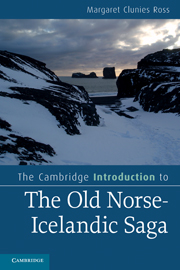Book contents
- Frontmatter
- Contents
- Tables
- A preface on practical issues
- Acknowledgements
- Abbreviations
- Chapter 1 Medieval Iceland
- Chapter 2 What is an Old Norse-Icelandic saga?
- Chapter 3 The genesis of the Icelandic saga
- Chapter 4 Saga chronology
- Chapter 5 Saga subjects and settings
- Chapter 6 Saga mode, style and point of view
- Chapter 7 Saga structures
- Chapter 8 The material record: how we know the sagas
- Chapter 9 Changing understandings of the sagas
- Notes
- Glossary of technical terms
- Guide to further reading
- References to volumes in the Íslenzk fornrit editions of Icelandic sagas
- Index
Chapter 3 - The genesis of the Icelandic saga
Published online by Cambridge University Press: 05 June 2012
- Frontmatter
- Contents
- Tables
- A preface on practical issues
- Acknowledgements
- Abbreviations
- Chapter 1 Medieval Iceland
- Chapter 2 What is an Old Norse-Icelandic saga?
- Chapter 3 The genesis of the Icelandic saga
- Chapter 4 Saga chronology
- Chapter 5 Saga subjects and settings
- Chapter 6 Saga mode, style and point of view
- Chapter 7 Saga structures
- Chapter 8 The material record: how we know the sagas
- Chapter 9 Changing understandings of the sagas
- Notes
- Glossary of technical terms
- Guide to further reading
- References to volumes in the Íslenzk fornrit editions of Icelandic sagas
- Index
Summary
In Chapter 2 I attempted to define what a saga is, and what it is not. We have now seen that there are many respects in which Old Norse sagas share characteristics with other kinds of medieval texts. There are many areas of overlap with other narrative kinds, especially with historical and annalistic writing, as many sagas are historical in a broad sense, and with didactic and educational writing, such as hagiography and biography, both major medieval narrative genres. Even the fact that most sagas were written in a Scandinavian vernacular rather than in Latin is not an absolute distinguishing feature, as we have seen that some early texts that have some similarities to the saga were written in Latin. Finally, we cannot say for certain that saga composition was originally an exclusively Icelandic practice, although it probably became so from the end of the twelfth century.
We have reviewed evidence that historical writings in both Latin and the vernacular, which have at least some major characteristics of the saga, were produced in Norway by Norwegians in the late twelfth century. However, what I have already characterised as a developed saga style, exemplified in Chapter 2 by a passage from Egils saga Skallagrímssonar, cannot be found in extant Norwegian writing from the medieval period. Whether it once existed but somehow did not survive is a question that we cannot answer. It seems that a great deal of the literary activity in thirteenth-century Norway was motivated directly from the court and the Church; thus the translations of romances from French and Anglo-Norman fostered by King Hákon Hákonarson did not apparently spark a wider vernacular literary movement in Norway. The Norwegian scholar Knut Liestøl made a case for the probable existence of oral family sagas in Norway in the medieval period, based on the existence of legends of comparable type and folktales recorded in Norway during the nineteenth century, but there is no evidence from the Middle Ages to support this view. In the absence of positive evidence of Norwegian saga production, then, we are justified in changing our reference from ‘the Old Norse-Icelandic saga’ to ‘the Icelandic saga’, and this change is reflected in the title of the present chapter.
- Type
- Chapter
- Information
- Publisher: Cambridge University PressPrint publication year: 2010

